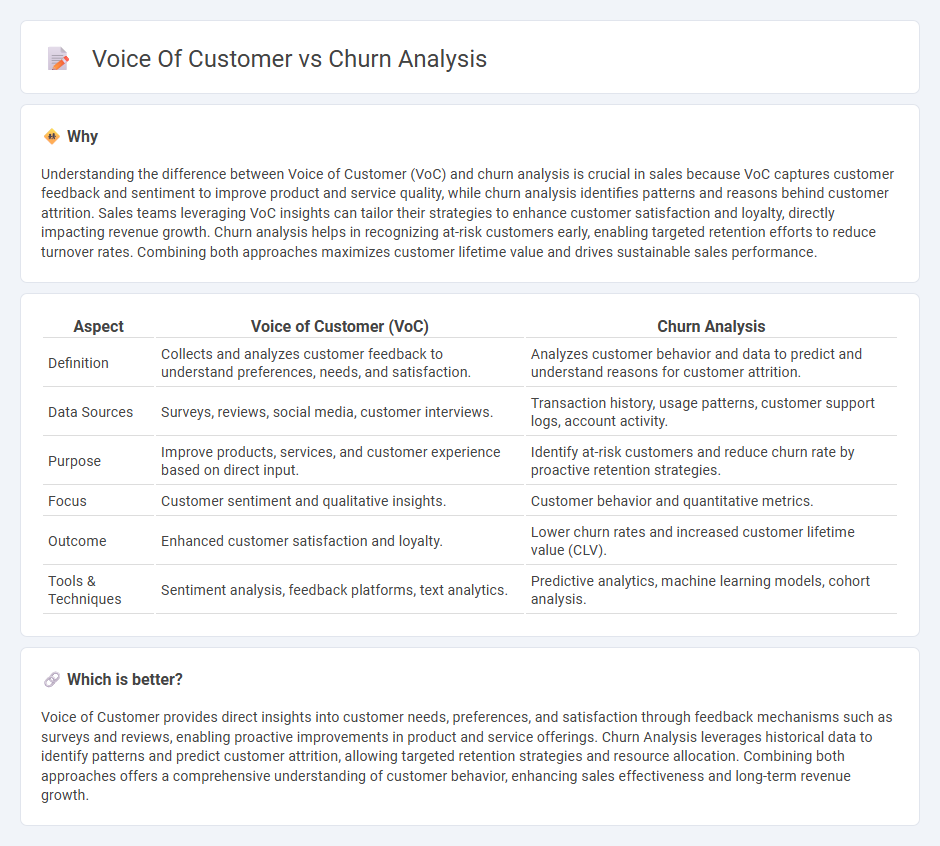
Voice of Customer analysis captures direct feedback and sentiment from buyers, revealing key drivers behind purchasing decisions and satisfaction levels. Churn analysis examines patterns and behaviors leading to customer attrition, identifying risk factors that impact retention rates. Explore how integrating these insights can optimize sales strategies and boost customer loyalty.
Why it is important
Understanding the difference between Voice of Customer (VoC) and churn analysis is crucial in sales because VoC captures customer feedback and sentiment to improve product and service quality, while churn analysis identifies patterns and reasons behind customer attrition. Sales teams leveraging VoC insights can tailor their strategies to enhance customer satisfaction and loyalty, directly impacting revenue growth. Churn analysis helps in recognizing at-risk customers early, enabling targeted retention efforts to reduce turnover rates. Combining both approaches maximizes customer lifetime value and drives sustainable sales performance.
Comparison Table
| Aspect | Voice of Customer (VoC) | Churn Analysis |
|---|---|---|
| Definition | Collects and analyzes customer feedback to understand preferences, needs, and satisfaction. | Analyzes customer behavior and data to predict and understand reasons for customer attrition. |
| Data Sources | Surveys, reviews, social media, customer interviews. | Transaction history, usage patterns, customer support logs, account activity. |
| Purpose | Improve products, services, and customer experience based on direct input. | Identify at-risk customers and reduce churn rate by proactive retention strategies. |
| Focus | Customer sentiment and qualitative insights. | Customer behavior and quantitative metrics. |
| Outcome | Enhanced customer satisfaction and loyalty. | Lower churn rates and increased customer lifetime value (CLV). |
| Tools & Techniques | Sentiment analysis, feedback platforms, text analytics. | Predictive analytics, machine learning models, cohort analysis. |
Which is better?
Voice of Customer provides direct insights into customer needs, preferences, and satisfaction through feedback mechanisms such as surveys and reviews, enabling proactive improvements in product and service offerings. Churn Analysis leverages historical data to identify patterns and predict customer attrition, allowing targeted retention strategies and resource allocation. Combining both approaches offers a comprehensive understanding of customer behavior, enhancing sales effectiveness and long-term revenue growth.
Connection
Voice of Customer (VoC) data provides deep insights into customer satisfaction, preferences, and pain points, which directly influence churn rates. Analyzing VoC alongside churn metrics helps identify specific reasons why customers leave, enabling targeted retention strategies. Integrating these analyses enhances sales forecasting accuracy and improves customer loyalty initiatives.
Key Terms
**Churn Analysis:**
Churn analysis involves examining customer behavior and transaction data to identify patterns and predict the likelihood of customers discontinuing a service or product, using metrics like churn rate, customer lifetime value, and retention rates. Techniques such as machine learning algorithms and survival analysis help businesses target at-risk customers with personalized marketing and retention strategies, reducing revenue loss. Explore more about advanced churn analysis methodologies and how they integrate with customer feedback systems for comprehensive customer retention.
Retention Rate
Churn analysis quantifies customer attrition by examining patterns and predicting which segments are likely to leave, directly impacting Retention Rate metrics. Voice of Customer (VoC) captures qualitative data on customer experiences, enabling businesses to address pain points and enhance satisfaction to improve retention. Explore the differences between churn analysis and VoC to optimize your retention strategies effectively.
Customer Lifetime Value (CLV)
Churn analysis identifies patterns and factors leading to customer attrition, directly impacting Customer Lifetime Value (CLV) by predicting potential revenue loss. Voice of Customer (VoC) gathers qualitative feedback to understand customer needs and satisfaction, enabling personalized strategies that enhance CLV. Explore how integrating churn analysis with VoC insights can maximize customer retention and increase CLV.
Source and External Links
How to Conduct Churn Analysis: A Complete Guide - CleverTap - Churn analysis involves assessing customer behavior to understand why customers leave and improve retention by collecting data, calculating churn rate, and segmenting customers by demographics and usage patterns.
How to Do a Churn Analysis: 3 Quick & Easy Steps [2023 Update] - Churn analysis uses the churn rate formula to measure lost customers relative to the total, focusing on KPIs like engagement, usage trends, and support ticket volume for actionable insights to reduce churn.
Customer Churn Analysis: How to Identify and Reduce Churn - Effective churn analysis requires defining churn rate, identifying churned customers using comprehensive data platforms, and analyzing customer feedback and behavior to develop retention strategies.
 dowidth.com
dowidth.com